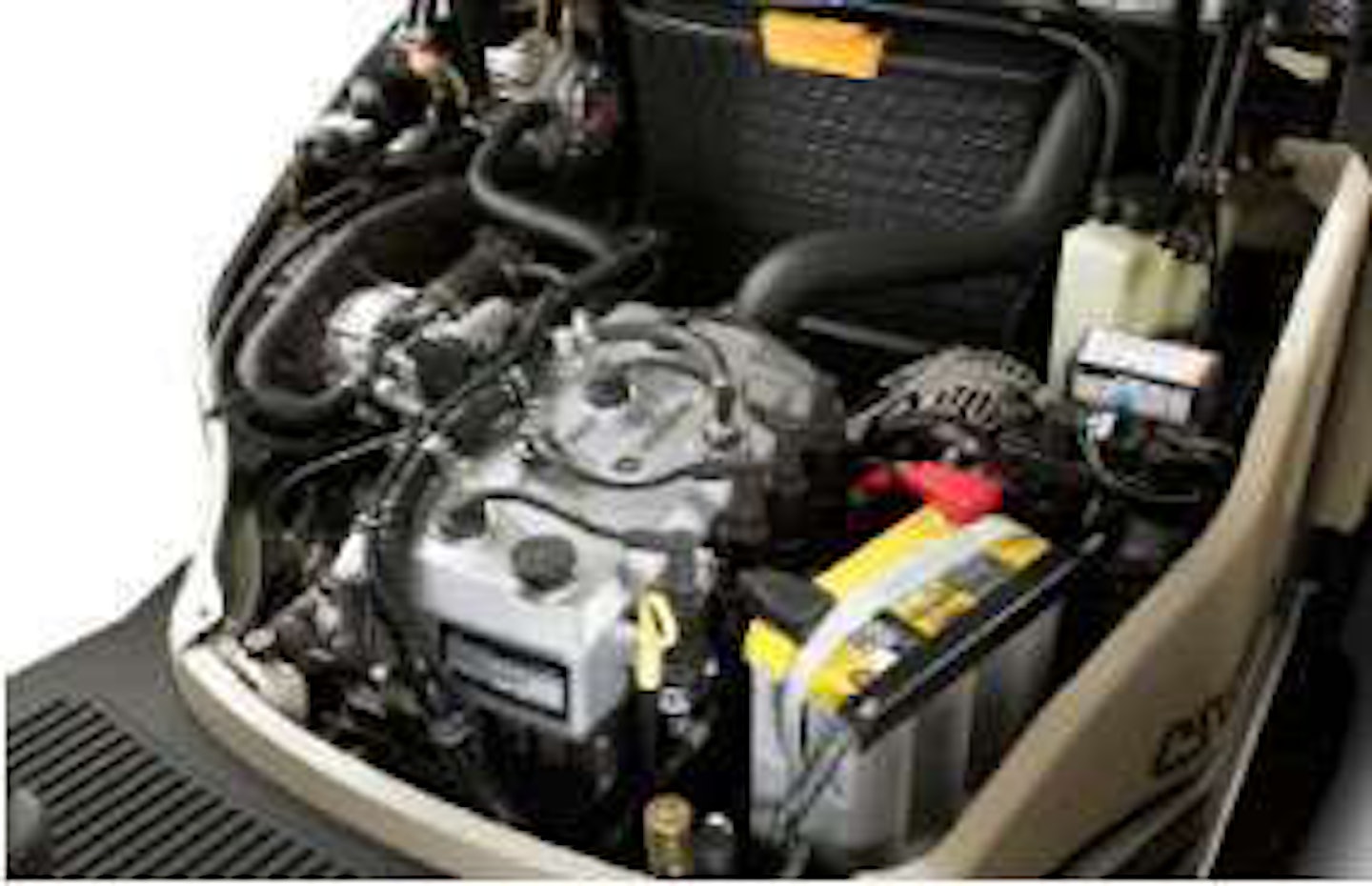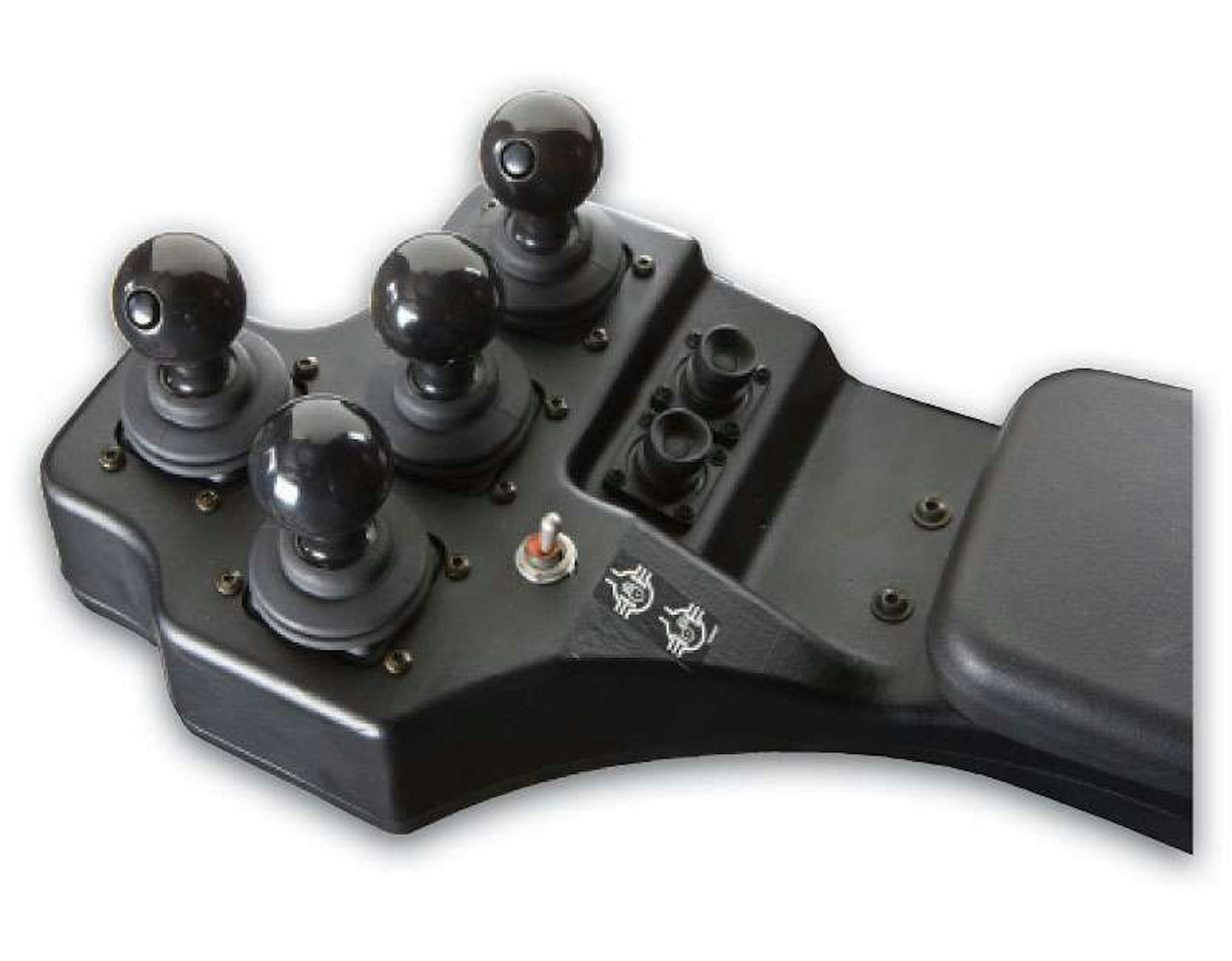One-pass gravel
How one contractor converted a simple idea into an attachment that creates stakeless road beds
By Marcia Gruver
Myron Mulletts gut told him there had to be an easier way. As owner of Mullett Excavating, Westcliffe, Colorado, he had received a multiyear military contract to lay gravel on 90 miles of road in nearby Fort Carson. The wide, 32-foot road, designed in part to handle tanks, required 4 inches of gravel on each side and a 2-percent crown. Mullett figured the tight-tolerance job would call for driving three rows of grade stakes one on each side and one in the center. He wasnt in the mood to drive all those stakes.
So he began to wonder: Would a box blade attached to the front of a dozer blade eliminate the need for stakes?
Well, no, everyone told him when he started asking around. Hed never be able to keep the gravel from going under the sides and throwing off the grade.
But Mullett still thought the idea had merit, so he tinkered with a snow plow blade, putting adjustable skids on each end, and then attaching it to an old dozer. He also put a plow device on each side of the blade that directed the gravel underneath the blade and away from the skids. Using the down force of the dozer, the skids rode on the subgrade, keeping the attachment at grade, allowing the blade edge to screed the gravel to grade as it passed underneath.
The make-shift set up worked, laying gravel at the required tolerances and maintaining grade, all without stakes. Not only did we do the project faster, our end product was much better, Mullett says.
Beyond a stakeless operation, Mullett had another impetus with his experimentation: accurate gravel placement. If a contractors being paid for 8 inches of gravel, he only wants to put down 8 inches, Mullett says. Since this stays on the subgrade, if your subgrade is right, it will place the correct amount of gravel.
Mullett knew he was on to something, so after the first job he created a from-scratch fixed 18-foot prototype his company still uses. We tried to bury it in gravel to see how much we could do in one day, using 20 belly dumps and hauling three loads per hour, he says. We laid down almost 18,000 tons of gravel in 10 hours straight.
These prototypes lead to AggreScreed, an attachment Mullett is marketing through his fledgling company, TerraTec Industries.
Adjusting to the job
One key to AggreScreed is its adjustability. The blade width, side skids and the blade edge are all adjustable. The width can change from 16 to 24 feet in 1-foot increments. In the 24-foot position, the attachment is capable of laying down gravel to spec, complete with a crown, in one pass down the middle of a standard two-lane road.
AggreScreeds width is adjusted by 24 bolts 12 on each side in a process that takes 40 minutes manually. Once the bolts are removed, the attachments hydraulic system, controlled by a box mounted in the dozer cab, extends or retracts the blade to a preset position. Reattach the bolts into the pre-drilled holes and youre ready for the next job.
Adjustability turned out to be the biggest design challenge, since Mullett sought an economical solution that didnt take a lot of time to change. Because the hydraulics are used only when adjusting the width and skid heights, Mullet used a separate hydraulic system for AggreScreed rather tapping into the host dozers system.
The heights of the skids on each side also adjust, up to 15 inches. When determing skid height, Mullett figures in an additional amount for compaction, depending on the type of aggregate used.
By adjusting the slotted blade edge up or down the attachment can achieve up to a 3 percent crown.
AggreScreeds width limits it to being used for uncompacted gravel and light materials. One contractor approached Mullett about using it for a 1-inch dirt pass. I think it would work for that small of a pass, but its not for pushing dirt, he says.
Mullett says between the decrease of labor and the accuracy of gravel placement, the attachment could be paid for after placing 10 miles of road. At $12 to $14 a ton, the savings in gravel costs alone can make a big difference, he says. In addition to truck drivers, the operation requires two people the dozer operator and someone to operate an auxiliary machine to reposition any misplaced gravel.
Coming soon
A natural add-on will be GPS and laser, which Mullett plans to offer in the near future. Such add-ons, however, will add significantly to AggreScreeds anticipated $65,000 cost.
Two other models are also in the planning stages, one that would adjust from 10 to 15 feet wide, and a fixed blade for skid steers. We see the skid steer product used for creating trails or large shoulders, says Mullett. And he envisions a trailer capable of hauling the 6,000-pound attachment at full width, so it wont have to be retracted for transport.
Mulletts anxious to see what uses other contractors can make of the AggreScreed. Let anyone use his or her imagination when it comes to applications, he says. Right now, its for laying gravel, but who knows what someone might come up with? EW
AggreScreed at a glance
Host machine: 125- to 200-net-horsepower dozer with straight, six-way blade
Attach/detach time: Up to 30 minutes
Width: 16 to 24 feet, extending in 1-foot increments
Height: 4 feet
Weight: 6,000 pounds
Depth of gravel: Up to 15 inches, adjustable at any increment
Crown: Up to 3 percent
To learn more about Mullett Excavating, check out Equipment Worlds February issue, where the company will be featured as one of our 2009-10 Contractor of the Year finalists.
From idea to market
Manufacturing was not Myron Mulletts initial goal. He first asked the manufacturer of the snow plow he had converted into the first AggreScreed prototype if the company had any interest in the idea. It said no. He also searched for any similar products, and failed to find any. He finally came to the conclusion it would be best to take the product to market himself. That route would require help.
Mullett applied for the AggreScreed patent more than four years ago, a process full of delays and discouragement. This past November, however, the U.S. Patent Office told him his patent had been approved.
Mullett used the patent process time to not only improve his product but also line up how he would get the attachment to market, knowing the effort would require talents outside of his skill set. About two years ago, a mutual friend introduced him to Tim Lorenzen, now TerraTec Industries chief operating officer. Mullet calls Lorenzens background in manufacturing and sales a natural for his new company. Together, they have lined up an industrial designer, fabrication shops, and worked with a local marketing communications firm to create the company and product name, logo, website and promotional materials.
One of their key marketing pieces will be a DVD showing the attachment in action. Once contractors can see what it does, theyll understand, Mullett says.
For more information, go to www.terratecind.com.
Editors comment
 The simplicity of Myron Mulletts invention makes you shake your head, something he readily admits. Ive thought, Why hasnt this been done before?, he says. Its not difficult. But it did take someone with experience Mullett has more than 20 years in construction and the willingness to experiment. And once he realized he had hold of something, he had to have the tenacity to see his creation through the patent gauntlet. A number of contractors have converted great ideas to sheet metal, but the process of bringing those ideas to market is daunting. Not only has he created a potential game-changing attachment, Mullet gives us a great template on how its done.
The simplicity of Myron Mulletts invention makes you shake your head, something he readily admits. Ive thought, Why hasnt this been done before?, he says. Its not difficult. But it did take someone with experience Mullett has more than 20 years in construction and the willingness to experiment. And once he realized he had hold of something, he had to have the tenacity to see his creation through the patent gauntlet. A number of contractors have converted great ideas to sheet metal, but the process of bringing those ideas to market is daunting. Not only has he created a potential game-changing attachment, Mullet gives us a great template on how its done.
Marcia Gruver
Komatsu Hybrid PC200LC-8
Dig with diesel, swing with electricity
By Tom Jackson
Back when diesel was cheap and carbon was something that accumulated inside your fireplace, nobody cared about how much fuel it took to move a ton of dirt. But in this new century with uncertain fuel prices, fierce debates over global warming and the EPA regulating engine emissions (and perhaps even carbon dioxide) the major heavy equipment companies have pushed their engineering staffs to find sustainable paths into the future.
For Komatsu, the beginnings of that sustainable future came into focus in the late 1990s when company engineers started developing an electric swing motor. In 2001, the engineers took the prototype to a marketing team and the combined teams began the process that would, after further engineering innovations, result in the introduction of the Hybrid PC200LC-8 excavator that uses both hydraulic and electric power.
Komatsu had introduced a hybrid forklift in 2007 that offered a 20-percent reduction in energy use compared to standard electric powered models. There are more than 400 of these units operating in Japan today. But a 20-ton excavator with its massive torque requirements and 30,000 pounds of digging force was another story.
Getting the feel right
The main engineering challenge was to combine the hydraulic and electric sources of power in a way that would give operators the same performance and feel of an all-hydraulic machine. In a conventional excavator, the dig and swing actions are powered by the same hydraulic system. In Komatsus hybrid system the boom, arm and bucket still draw power from the hydraulics, but the swing motor that rotates the upper structure uses electrical power. To get the two sources of power to mesh seamlessly Komatsu developed a digital controller that manages the handoff of power from hydraulic to electrical in seamless fashion. A great deal of effort went into programming the controller and numerous real world simulations were used to create the software logic. Beta testers in Japan put the prototypes through a lengthy testing process and worked with the engineering staff to get the feel of the machine right.
Another challenge was even the best conventional batteries cant store enough electrical power or discharge it fast enough to effectively rotate the upper structure of a 20-ton excavator under load and at sufficient speed. The solution was to use a large ultra-capacitor. Like a battery, an ultra-capacitor stores electrical energy, but unlike a battery it stores and discharges huge amounts of electricity in a short periods of time. And since the ultra-capacitor doesnt rely on chemical reactions (like automotive batteries) its maintenance free.
How it all comes together
There are three main components to the Komatsu hybrid system: the generator motor and the previously mentioned electric swing motor and ultra-capacitor. The generator motor is positioned between the engine and hydraulic pumps. It generates electricity to charge the ultra capacitor when insufficient energy can be returned by the swing motor and the machine is placing structures into the ground over the front for long periods of time, or during extended travel distances. It also receives energy from the ultra-capacitor to generate hydraulic power to the boom, arm and bucket during times of peak demand.
The electric swing motor uses energy from the ultra-capacitor to rotate the upper structure and also recovers energy from the braking action of the upper structure and redirects this energy back into the ultra capacitor. Constantly charging and discharging, the ultra-capacitor serve as a sort of energy sponge, absorbing energy from the generator and swing brake and releasing it on demand to the swing motor or as a boost to the working end of the machine when peak power is needed to pull a bucket through stubborn or heavy material.
The ultra-capacitor is tied to an inverter that takes the AC electricity from the generator and swing motor and converts it to DC. The electric swing motor and ultra-capacitor have their own cooling system, with housings that allow coolant to circulate around them and a dedicated secondary radiator and electric coolant pump.
What a difference it makes
With the ultra-capacitor functioning as a ready reserve of instant power, the Hybrid PC200LC-8 offers some game changing numbers in the fuel economy department. Fuel savings of 25 to 40 percent have been documented in actual customer applications, says the company. With that comes an equivalent reduction in carbon dioxide emissions. In a typical hour of operation it emits 25 fewer pounds of carbon dioxide compared to a conventional PC200LC-8 excavator. Thats 25 tons per year based on 2,000 operating hours in a year. The best fuel economy comes in applications with a high rate of upper structure swinging, such as digging and dumping, as opposed to less kinetic work like craning or pipe laying.
The Hybrid PC200LC-8 also uses a four-cylinder engine, instead of the traditional six. When the machine is not working or traveling the 138-horsepower engine idles at just 700 rpms. The super-low idle speed and the lack of stress on the engine results in appreciably lower noise levels. The machine is not only quieter overall, but the noise rises and falls at different times compared to a conventional excavator. Operators who gauge the effort of an excavator by how loud it gets may need to adjust their reactions.
Two factors affect the payback period for the Hybrid PC200LC-8 the cost of fuel and the additional cost of the machine. Currently Komatsu is conducting a market field evaluation in the United States with 10 machines in key areas. According to the company, the goal of the study is not only to determine the viability of the new technology in this market, but also to identify the value-price position. There will be 180 units at work in Japan by the end of March 2010, and the Hybrid PC200LC-8 was introduced to the Chinese market this summer. Komatsu chose the PC200 size machine since this excavator size category (20 to 22 tons) represents the biggest share of the market and offers the largest potential environmental benefit.
In Japan and China where the machine is already marketed it costs about 50 percent more than a conventional excavator. But with fuel savings on a machine logging 2,000 hour per year, that cost could be recouped in around five years. Any uptick in the price of fuel will shorten that payback period. And with EPA set to regulate carbon dioxide and various schemes to tax carbon emissions gaining popularity worldwide, the Hybrid PC200LC-8s relatively light environmental footprint will prove advantageous. EW
Get an explanation of how this hybrid will feel during operation by going to our digital edition www.EquipmentWorldDigital.com.
Editors comment
 Everybody talks about global warming. What I like about Hybrid PC200LC-8, is that Komatsu chose to do something about it.
Everybody talks about global warming. What I like about Hybrid PC200LC-8, is that Komatsu chose to do something about it.
Whether you believe that global warming is real or manmade isnt the critical issue. Most people would agree that the unrestrained consumption of petroleum based fuels will eventually become bad for the environment and bad for our economy.
Komatsu wisely chose to focus its hybrid ambitions on the excavator, the one machine that more than any expends a big part of its fuel budget in idle or lost to heat. But to focus strictly on fuel costs is to miss a more important reason to consider a hybrid environmental leadership.
More and more universities, hospitals, government agencies and large corporate clients are specing LEED certification (Leadership in Energy and Environmental Design, see www.usgbc.org) in their bid documents. To score points in the LEED system you have to show you can do the job with the least environmental impact. A hybrid excavator enables you to show clients, future clients, bankers, government officials and employees that when it comes to environmental stewardship you dont just talk the talk, you walk the walk.
Tom Jackson
At your fingertips
Deeres electro-hydraulic controls mimic the pattern and feel of conventional grader controls
By Marcia Gruver
 When designing its G-Series graders, John Deere knew one needed to offer electro-hydraulic controls on its Grade Pro (or GP) models. Its the only way to add the automation that is necessary to help less skilled operators, says Mike Kennedy, grader engineering manager for Deere. And Deere had plenty of experience with electro-hydraulic controls after incorporating them into their dozer and backhoe lines.
When designing its G-Series graders, John Deere knew one needed to offer electro-hydraulic controls on its Grade Pro (or GP) models. Its the only way to add the automation that is necessary to help less skilled operators, says Mike Kennedy, grader engineering manager for Deere. And Deere had plenty of experience with electro-hydraulic controls after incorporating them into their dozer and backhoe lines.
Since electro-hydraulic controls could take many forms, Deeres designers looked at several possibilities, including keeping them on the steering column as a way to calm resistance from another key group of customers: experienced operators.
Operating a grader is like playing a piano, says Kent Stickler, grader product marketing manager. Experienced operators know where all the keys are, and if that world is changed, they have to start all over. And so Deere opted to continue to use the conventional control pattern.
 But the decision to keep the traditional operating pattern didnt mean the GP controls would be the same ol, same ol. Deere moved the controls from the steering column to the operators seat, putting fingertip controls on each arm rest. Not only do these eight controls have the pattern of conventional grader controls, they also have the same size knobs, throws and spacing. The goal was to make them feel identical to what they were used to operating, says Kennedy. There are slight variations but theyre so small most people wont notice.
But the decision to keep the traditional operating pattern didnt mean the GP controls would be the same ol, same ol. Deere moved the controls from the steering column to the operators seat, putting fingertip controls on each arm rest. Not only do these eight controls have the pattern of conventional grader controls, they also have the same size knobs, throws and spacing. The goal was to make them feel identical to what they were used to operating, says Kennedy. There are slight variations but theyre so small most people wont notice.
The move did several things. First it opened up visibility to the grader blade, partially blocked by traditional controls. Once the linkages which extended from the controls to the floor to connect with valves underneath the floor were eliminated, Deere was able to lengthen the windows by about 4 inches.
Ergonomics also improved, since an operators hands rest on controls integrated into the seat. The electro-hydraulic controls incorporated lever steering, cross slope capability and return-to-straight buttons, designed to keep an operators hands comfortably on the knobs.
During our initial design stages, we tried placing the lever steering function in several locations, and finally decided the blade side shift lever was the best place for it, since that left-side control is not used as much as others, Kennedy says. A grader operator uses a combination of controls at the same time, so we wanted to place it where it wouldnt prevent them from using lever steer along with other operations.
Space constraints
Deere determined it would work within the parameters of its just updated D-Series cabs, which presented space challenges. Details requiring attention including designing a right-size base and control lever and reducing the travel of the transmission shift lever. Working with customer groups, engineers experimented with several button locations on the control knobs.
They knew they also needed room for the steering wheel, considered a requirement in the GP models. There are some applications where operators are more comfortable using a steering wheel, so we didnt want to get rid of it, Stickler says. These jobs include high speed operations, precision work up against a curb, and grading cul-de-sacs. Lever steering can be turned off with a button push, a consideration when working slopes or plowing snow.
Since the steering wheel would be pulled in between the seat-mounted controls when in use, it had to meet certain width constraints, which lead to a reduction in size.
Deere has applied for a design patent on the resulting control layout.
Testing
One design challenge was making sure the new controls had the same durability as the previous ones. Since a grader operator will put the controls through millions of cycles, they had to meet durability tests. The toughest areas for our GP controls were meeting the mechanical cycle test requirements, the electro-magnetic requirements and providing well sealed and durable buttons, Kennedy says.
About a year before production started, four prototype graders were sent out to customers in a variety of applications. At this stage, designers were particularly concerned with dialing in the ergonomics of the seat-mounted controls, and matching the comfort level to the majority of operators. Deere knew by marrying the controls with the seat that the seat would require more adjustability. At this point, other modifications were made, such as moving the float switches, and properly metering the hydraulic valves in order to adjust the lever feel.
The GP models (Deere also offers traditional controls on its G-Series machines) have a grade control intergration system that gives customers their choice of using either a Topcon or Trimble system. Designers knew these systems would come with a monitor, creating a visibility problem if it was mounted to the side of the grader system monitor. So Deere put redundant wiring in the cabs right hand post, which allows customers to reposition the vehicle monitoring system there, allowing for the grade control system in the original monitor position.
Standard on GP models is automated cross-slope, which simplifies holding a consistent slope by reducing operation to a single lever. The operator selects the desired slope and side of the blade that will be manually controlled. Once set the system automatically adjusts the opposite blade-lift cylinder to maintain the slope.
In production since May 2009, the GP system on the G-Series graders has a list price of $25,625, which includes the fingertip controls, grade control integration, cross slope control, return-to straight, deluxe heated seat, and the choice of both lever steering and a conventional steering wheel. The GP option is available on all G-Series graders. EW
Editors comment
 Grader operators will feel at home with Grade Pro controls which was the whole point behind its creation. Its easy to see why Deere has applied for a design patent on these fingertip controls: the position of the control knobs are easy on the hands, not to mention the back. Learning how to finesse a grader still requires a great deal of experience but now its a much more comfortable task.
Grader operators will feel at home with Grade Pro controls which was the whole point behind its creation. Its easy to see why Deere has applied for a design patent on these fingertip controls: the position of the control knobs are easy on the hands, not to mention the back. Learning how to finesse a grader still requires a great deal of experience but now its a much more comfortable task.
Marcia Gruver
